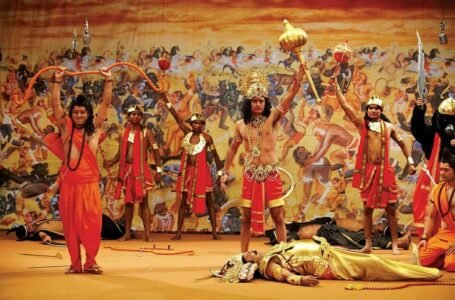Padma Shri Sita Devi -Pioneer of Madhubani painting

~Anushka Sengupta
The region of Mithila, which lies in the state of Bihar, northern India, and extends into Nepal, is well noted for its unlimited creativity as depicted in its range of paintings. Butterflies often depicted by the women of Mithila- renowned for portraying scenes that go beyond landscapes and animals- appear in Madhubani paintings, also termed as Mithila Paintings. These artworks are still preserved through their fingers, twigs, brushes and organic paints even to this very day. This exemplifies their deep-rooted social structure drawing from nature, concepts of good and evil while at the same time, through new age elements reflect the cultural identity of a land whose civilization is steeped in love and religion, often explained through themes of fertility. Madhubani or “honey from the forest” gained national prominence when artists like Sita Devi were honored with state awards, followed by Padmashiri Jagdamba Devi, who received the Padma Shri in 1975. Showcasing the region’s artistic brilliance, Madhubani paintings echo the pride of india and are celebrated worldwide as one of the best traditional art forms.
Folk art mirrors the attitudes of the culture to which it belongs, presenting its ethics, traditions, and values in a unique and uncomplicated way. Colorful geometric motifs define the “Madhubani” paintings, an exquisite form of folk art that paints the Mithila region of India. It holds tremendous significance in a patriarchical society since most folk art is practiced by the women of the Mithila region. Madhubani paintings are said to have evolved in the Jitwarpur and Ranti villiages that surround the Madhubani town. The genesis of the “Madhubani” painting is rather vague, but remains conjectured to the mythological Indian epic ‘’Ramayana.’’ Somewhere around the 7th to 8th Century BCE, Janak, the king of the Mithila Kingdom, is rumored to have commissioned the creation of these paintings to eternalize the memories of his daughter Sita’s marriage with Maharaja Rama. The paintings vividly encompass the life,traditions and culture of the people which is their exclusive domain. Artistic skills are acquired from mothers to daughters through family lineage. Girls are taught to wield a brush and paint at a tender age. However, the decoration of the Kohbar (the wedding room) is marked as the most delicate phase. It is the chamber of the house set aside for the newly married couple to reside in. Although paintings are a specialty of women, marketing requirements are increasingly taken up by men. Together with the higher engagement levels from men, the custom processes of creating this art have also undergone some changes.
Prior to commencing the painting, women customarily perform a prayer to the gods to solicit their goodwill in achieving their goals. For its creation, the cotton wrapped over a stick of bamboo is utilized as a paintbrush. The colors that are used are prepared by the artists through various means. There are no visible gaps between different subjects in the painting; they are separated by means of geometric outlines. The black color is made by combining blight and cow dung, yellow is from turmeric and the milk of a Banyan leaf, blue comes from indigo, red is from Kusum flowers, green comes from the leaves of an applewood tree, white is from powdered rice, and orange comes from the flower Palash. It was in 1962 CE that the commercialization of Madhubani paintings commenced after an artist from overseas got interested in the murals while touring the place. He convinced the women to replicate those drawings on paper so that he could take them to his country. The concept worked extremely well, which marked the beginning of commercialized Madhubani paintings.
Differing methods of painting have appeared since then. Women from Mithila region, who are immensely gifted in this form of art, have brought their art to the level of an artistic spectacle, crossing geographical, social and cultural barriers. Some government officials for example tried to market these paintings to increase their earnings by discovering the artistic talent showcased in these paintings in the 1960s CE. They accomplished this by convincing women painters to replicate the paintings on paper, which also marked the beginning of the commercialization of their art. The efforts of cultural groups, NGOs and local government have placed the Madhubani art at an even higher pedestal of recognition and popularity. The government of Bihar intended to use the Madhubani art to enhance the beauty of railway stations and coaches. Although the main artist, almost the entire workforce, were not paid, the railway did fund the necessary materials for the artists like colors, brushes, and security for their convenience with the condition that they could write their name with contact numbers which served as an advertisement for their art. Many designers have come up with the collection of traditional dresses which are intricately crafted using Madhubani art. Others daily use items which are painted with Mithila art such as pen-cases, bags, and diaries and these are also very popular and highly sought after.
Sita Devi is regarded as the first and foremost artist of Madhubani. With her relentless efforts and strong will, she was successful in bringing Bharni form of Madhubani paintings out of homes and exhibiting it publicly throughout India and abroad. Another famous Madhubani artist is Godavari Dutta who was born in pre-independent India and became widely known after the age of 93 due to the advertisement of these paintings. Godavari Dutta was encouraged by her mother who was also a Madhubani artist. Sita Devi (1914-2005) is one of the foremost figures in the history of Indian folk art; she is celebrated for her revolutionary influence on the traditional Madhubani painting, one that transformed the provincial trade into a globally recognized art essential. Her work not only embellished the cultural fabric of India but also had the social activist dimension whereby she was helping empower rural society, especially the womenfolk, through her art. For all her good work, she received a Padma Shri in 1981, one of India’s highest civilian awards.
In 1914, Sita Devi was born in the vicinity of Saharsa, Bihar. She belonged to a Mahapatra Brahmin family. Even in her youth, she showed interest toward art and went on to teach herself how to paint using leftover paints from local potters. The first paintings she created were in Madhubani style, which was common in Mithila’s region. This style, both meticulous and colorful, was usually created by women during religious rituals and festivals. After her marriage, she moved to the village Jitwarpur where she settled and mastered the craft of painting. It was at this Jitwarpur that she started gaining fame for her artistic innovations. Sita Devi’s paintings were different for her contemporaries in both theme and style, and that set her apart. While traditional Madhubani paintings were rendered onto walls with the use of natural paints, Sita Devi created the bold move of transferring the art to paper, making it possible for commercial use. Her paintings popularized the bharni style which used strong colors instead of thin lines and therefore was much more expressive.
Deities Krishna and Radha were among the characters featured in her paintings and from Hindu mythology, they were her favorite. Devi also painted contemporary scenes like the World Trade Center and Arlington National Cemetery, which helped merge contemporary culture with classical art. This diverse style won her global recognition and proved how flexible Madhubani Art could be. Sita Devi has received exceptional recognition for her art both in India and overseas. In 1969, the Government of Bihar gave her the Bihar State Government Award for her outstanding contribution to Madhubani painting. Her name gained prominence in the world of art and by 1981, she received the Padma Shri award conferred by the government of India. In 1984, she further secured her legacy by being honored with the Bihar Ratna Samman. Her works have been exhibited in over ten countries and forms part of esteemed collections from the Victoria and Albert museum London, the Los Angeles County Museum of Art, the Philadelphia Museum of Art, the Musée du Quai Branly Paris and the Mithila museum in Japan .
In addition to her former accomplishments in art, Sita Devi took interest into the upliftment of the village Jitwarpur. With her position, she campaigned for the construction of a primary school, the first in the village, which was later promoted to a secondary school. In addition, she contributed significantly towards the implementation of brick-paved roads and the extension of electricity to the area. Having faith in the power of art as a tool of change, Sita Devi set up programs for the teaching of Madhubani painting to local people, especially women. Her efforts helped many become financially independent and heightened community pride. Such was her impact that the affectionate title ‘Ma’ given to her by the villagers underscores her maternal influence. Sita Devi’s legacy is alive today in the painting of her students who still practice and innovate upon the techniques and styles of Madhubani painting. Her contribution has inspired many artists and activists. The institutions and people she guided to build the culture where these contributed to art and society, actively preserve her art and vision, becoming dynamic parts of India’s tradition. Life and work of Padma Shri Sita Devi showcase the perfect balance between social consciousness and artistic excellence. Being the first to advance the cultural dimension of India by incorporating diverse forms of social change through art, she showed the world what can be achieved with community dedication.


